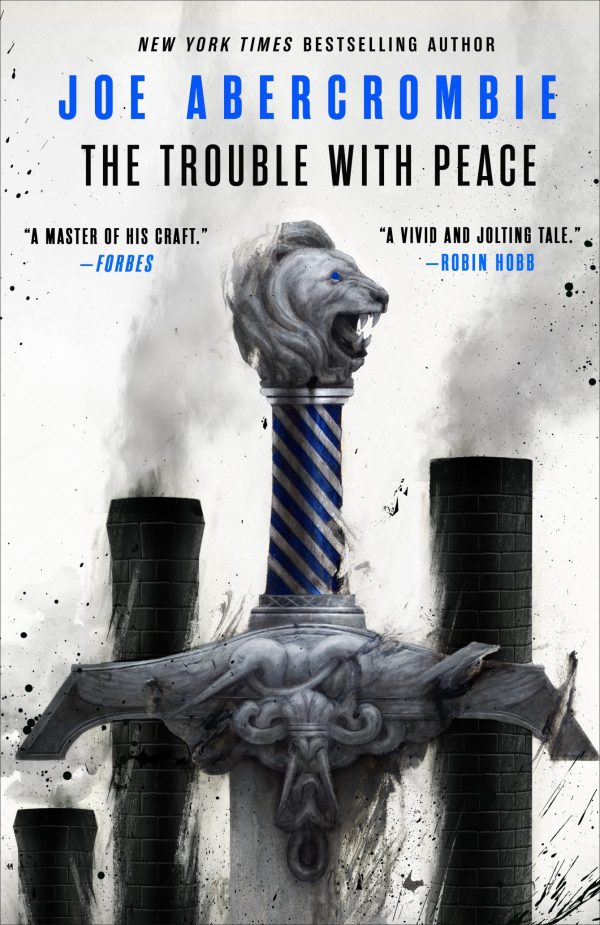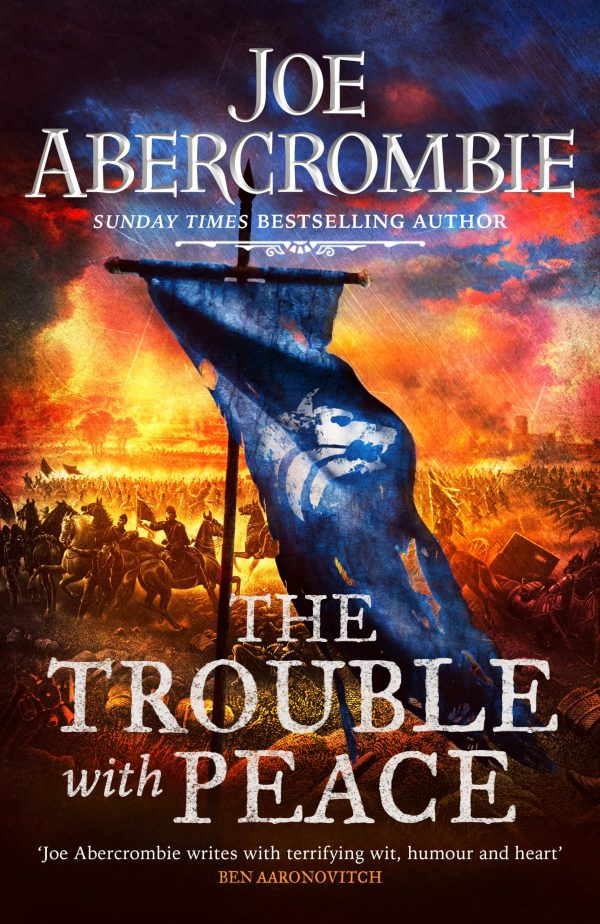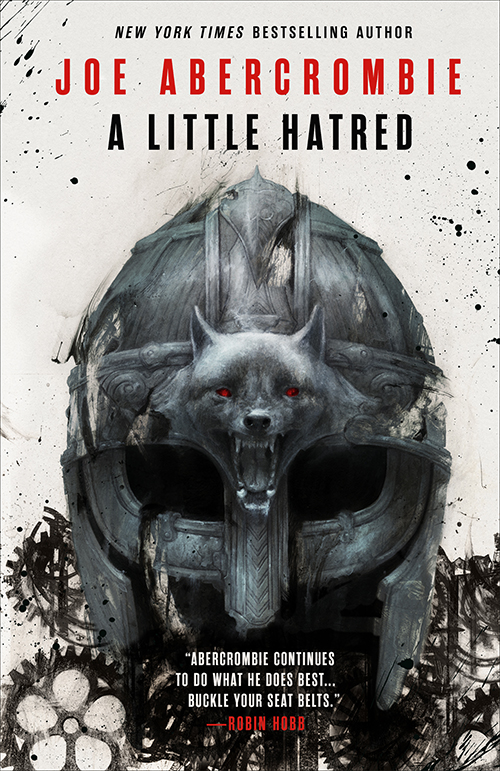A Little Hatred, the first book in Joe Abercrombie’s Age of Madness trilogy, came out merely one year ago. That book set the pieces on the chessboard and made their first moves. Now The Trouble with Peace has arrived and the powers plays are being set in motion on all sides.

As it begins, it looks as if the events of A Little Hatred have come and gone, with the most obvious example of Orso dan Luthar already being crowned king and dealing with Union bureaucracy. However, the events of the Battle of Red Hill, the duel in the circle between the Young Lion and the Great Wolf, and the uprising in Valbeck have altered the characters significantly. Savine dan Glokta is traumatized by the events of Valbeck, Leo dan Brock is struggling with the changes within the nation he fought for, Rikke forced the Long Eye open and now cannot keep it shut, and Orso is struggling to figure out what exactly the King of the Union is supposed to do.
Of course, the exceptions are Victarine “Vick” dan Teufel and Clover, who, due to failings and tragedy, have learned to do whatever is they need to to survive. Vick has made herself a shell, a husk of a person who puts on a mask to do her job, and she does it well. Still, it’s only a way to have some control, because she won’t admit to herself she has no control over her life and won’t confront the decisions she has made to survive. On the other hand, Jonas Clover is very comfortable with what he’s done to survive but now is faced with choices that could mean than just doing what it takes for him to come out the other end alive. The Trouble with Peace will put their (lack of) convictions through the ringer.

This is not a short book at nearly five hundred pages, yet the story seemed to breeze by. By the end, it felt as if events went by so quickly I had to pause and take stock of what was happening. In A Little Hatred, the characters were kept apart for most of the book by different circumstances. It wasn’t until some of the final chapters of the book that all of them came together. Before then, most of the point-of-view characters went in and out of orbit with each other. The difference here is most of the points-of-view happening in close chronological order or features another point-of-view character’s events within. Thus, this feeling made the events seem to go by very quickly, and made reading more exciting as there was no pause between chapters. A Savine chapter featured Leo, then lead into a Leo chapter that dealt with Orso, leading into an Orso chapter. It became more seamless as the book went on. A Little Hatred felt like a Venn diagram of events that had overlapping consequences. The Trouble with Peace is more of multiple herds of animals moving slowly in opposite directions only to turn around and stampede towards each other.

The standout point-of-views of this book are King Orso and Rikke. More than any other characters, these two rise above the perceptions of those who doubted them in A Little Hatred. Their point-of-views drive the story forward and offer more hope and curiosity for the trilogy’s last book. Rikke and her Long Eye, the power that allows her to see glimpses of the future, has one of my favorite point-of-view chapters (entitled “Late”) in any Joe Abercrombie book. Without spoiling it, the author does something new with his style of transitions first introduced in The Heroes and creates an eerie look into what Rikke’s power entails. Besides that, it is exciting to try to guess what her visions of the future mean, and I’d recommend re-reading those sections once you’ve completed the book.
The differences between King Orso and Governor Leo dan Brock make the thematic backbone of this book. Without spoiling it, I cannot express enough how much of an idiot Leo dan Brock is as in this book. Being a hero has completely gone to his head. He may be a brave warrior, but being a government administrator is not his strong suit, nor are his politics. Everyone who tries to manipulate him succeeds to the point of any sympathy for him being sapped away by the end of the book. Orso, on the other hand, comes off looking in this book bright as sunshine. He is self-aware of all his faults and works to either improve them or accepts them. His mixed nationality of Styrian and Union makes him more accepting of the different kinds of people coming to the Union from the other parts of the world. Meanwhile, Leo continues to be prejudice, wishing for the Union to the way it used to be, and in part, his bias informs his dislike of the way King Orso is running the country. Leo’s hubris goes so far as not to be able to accept parts of himself.
Though this new trilogy is new reader-friendly, long time readers will eat up every part of the past that gets brought up. Abercrombie gives so many satisfying nods to his previous books with old characters while never taking away from the new ones. If A Little Hatred was informed by events in The Heroes, then The Trouble with Peace follows suit by referencing Best Served Cold. If that pattern continues by hearkening back to Red Country in the next book, my excitement for it is high for my most anticipated book of the 2021. Red Country is, in my opinion, Abercrombie’s most outstanding work.
When you read a large body of work such as Joe Abercrombie’s, especially when it is set in the same world, you become overly familiar with where they’re trying to lead and where that path tends to end up. Therefore, it such a nice feeling when they can continue to surprise you without completely changing what becomes a comfortable familiarity with their work. That sounds all cozy, but The Trouble With Peace continues to be grim, brutal, with the dash of that Abercrombie wit that makes it all enjoyable to read. It’s odd, a lot of the characters if you could talk to them at the end of this book would disagree with this assessment, but this book feels more hopeful than the previous book in the world of the First Law since The Blade Itself.
That being said, the third book could wash all that hope away, repeating the same cycle as the original trilogy, and I would not be surprised nor would I necessarily disagree with it. Still, it makes the next book something to look forward to, to see if a real change could happen for this world even if it’s only a small change. As someone who prefers happy to bittersweet endings, based on Rikke’s omen about the lion, the lamb, and the owl, I worry about the conclusion. Will Bayaz continue to repress any change or progress that isn’t in his favor? Since the end of The Last Argument of Kings, Bayaz has been this looming villain in the background. He portrays himself as wise and amiable but is, in fact, arrogant and controlling. Therefore, every little hint the new books give that will lead to his possible downfall, I drink it up. The Trouble with Peace continues that trend.
The Trouble with Peace marks the ninth book set in this world. It’s not pleasant, and few characters get happy endings, yet it doesn’t feel as depressing as it should. Yes, there is violence, oppression, and injustice. Yet there is still room for laughter, growth, and hope, even when that hope is small. The introduction of the industrial age has not been kind. Not every antagonist’s despicable action results in their comeuppance, and not every protagonist gets what they deserve, but his books never leave me feeling unsatisfied. Except for Bayaz, every character that is subjectively good or evil, hero or villain, is a victim of circumstance. The real antagonist is the societies of this world, but Abercrombie makes it clear in The Trouble with Peace while change is difficult, it is not impossible. If the third book in the trilogy, The Beautiful Machine, is the last book set in this world, this reader will have no regrets even if it all ends in tragedy. A man lost in the desert must take such water as he is offered, no matter who it comes from.
